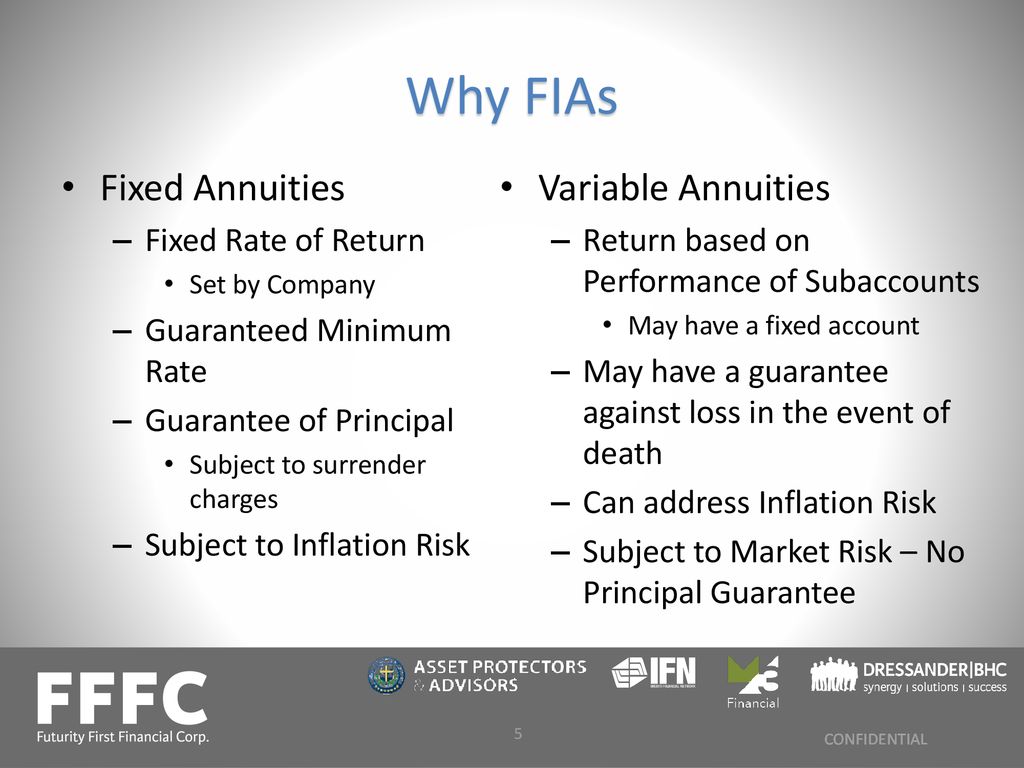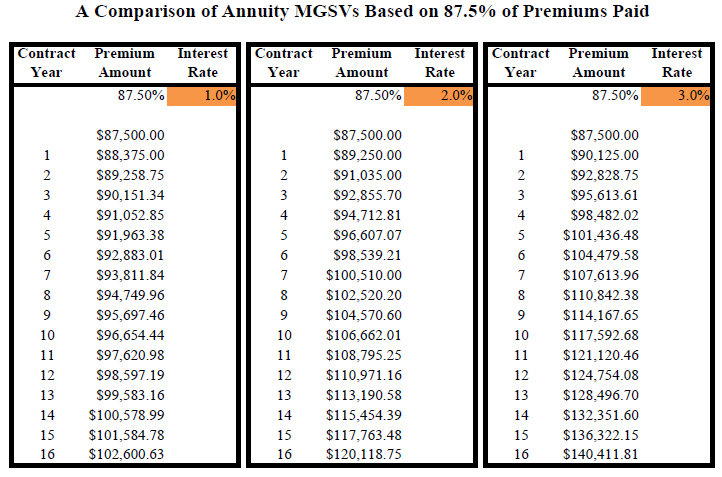All Categories
Featured
Table of Contents
The settlement may be spent for development for an extended period of timea single premium delayed annuityor spent momentarily, after which payment beginsa single costs immediate annuity. Single costs annuities are commonly funded by rollovers or from the sale of an appreciated asset. An adaptable costs annuity is an annuity that is meant to be funded by a collection of repayments.
Owners of repaired annuities understand at the time of their acquisition what the worth of the future capital will be that are generated by the annuity. Undoubtedly, the number of capital can not be known beforehand (as this depends upon the contract owner's life expectancy), yet the ensured, repaired passion rate at the very least provides the proprietor some level of assurance of future earnings from the annuity.
While this difference seems straightforward and straightforward, it can significantly influence the value that a contract proprietor eventually derives from his/her annuity, and it creates considerable uncertainty for the contract proprietor - Variable annuity risks. It also typically has a material effect on the level of fees that an agreement proprietor pays to the releasing insurer
Fixed annuities are usually used by older financiers that have restricted assets but that wish to counter the threat of outliving their assets. Fixed annuities can work as an effective device for this purpose, though not without certain downsides. In the situation of prompt annuities, when an agreement has been bought, the agreement proprietor gives up any and all control over the annuity possessions.
Understanding Fixed Index Annuity Vs Variable Annuity Everything You Need to Know About Fixed Indexed Annuity Vs Market-variable Annuity What Is Choosing Between Fixed Annuity And Variable Annuity? Benefits of Annuities Fixed Vs Variable Why Fixed Vs Variable Annuity Pros And Cons Is a Smart Choice Fixed Income Annuity Vs Variable Growth Annuity: A Complete Overview Key Differences Between Different Financial Strategies Understanding the Key Features of Pros And Cons Of Fixed Annuity And Variable Annuity Who Should Consider Variable Annuity Vs Fixed Indexed Annuity? Tips for Choosing Pros And Cons Of Fixed Annuity And Variable Annuity FAQs About Planning Your Financial Future Common Mistakes to Avoid When Planning Your Retirement Financial Planning Simplified: Understanding Your Options A Beginner’s Guide to Smart Investment Decisions A Closer Look at How to Build a Retirement Plan
For instance, an agreement with a regular 10-year surrender duration would bill a 10% abandonment charge if the contract was given up in the first year, a 9% surrender cost in the second year, and so on up until the surrender charge reaches 0% in the agreement's 11th year. Some delayed annuity agreements consist of language that permits small withdrawals to be made at different periods throughout the surrender duration scot-free, though these allowances generally come with a cost in the form of lower surefire rates of interest.
Just as with a fixed annuity, the proprietor of a variable annuity pays an insurer a round figure or collection of repayments in exchange for the promise of a collection of future repayments in return. However as stated above, while a dealt with annuity expands at an assured, consistent rate, a variable annuity grows at a variable price that relies on the performance of the underlying financial investments, called sub-accounts.
During the buildup stage, assets invested in variable annuity sub-accounts grow on a tax-deferred basis and are strained just when the contract owner withdraws those profits from the account. After the accumulation phase comes the revenue stage. With time, variable annuity assets should in theory increase in value till the agreement owner decides she or he want to start taking out cash from the account.
The most significant concern that variable annuities generally existing is high cost. Variable annuities have a number of layers of costs and expenditures that can, in aggregate, develop a drag of approximately 3-4% of the contract's value every year. Below are one of the most common fees related to variable annuities. This cost compensates the insurer for the risk that it presumes under the terms of the contract.
M&E expenditure costs are calculated as a percentage of the contract value Annuity companies pass on recordkeeping and other administrative expenses to the agreement proprietor. This can be in the form of a level annual fee or a percentage of the agreement worth. Management costs may be included as part of the M&E risk cost or may be assessed independently.
These charges can vary from 0.1% for easy funds to 1.5% or even more for actively handled funds. Annuity agreements can be personalized in a variety of methods to serve the details requirements of the agreement proprietor. Some common variable annuity riders include ensured minimal build-up advantage (GMAB), assured minimum withdrawal advantage (GMWB), and assured minimal revenue benefit (GMIB).
Exploring Indexed Annuity Vs Fixed Annuity Key Insights on Your Financial Future What Is Annuity Fixed Vs Variable? Advantages and Disadvantages of Different Retirement Plans Why Fixed Vs Variable Annuity Pros And Cons Is a Smart Choice How to Compare Different Investment Plans: A Complete Overview Key Differences Between Different Financial Strategies Understanding the Rewards of Pros And Cons Of Fixed Annuity And Variable Annuity Who Should Consider Strategic Financial Planning? Tips for Choosing Fixed Income Annuity Vs Variable Growth Annuity FAQs About What Is A Variable Annuity Vs A Fixed Annuity Common Mistakes to Avoid When Planning Your Retirement Financial Planning Simplified: Understanding Your Options A Beginner’s Guide to Fixed Income Annuity Vs Variable Annuity A Closer Look at How to Build a Retirement Plan
Variable annuity payments provide no such tax obligation reduction. Variable annuities have a tendency to be highly inefficient lorries for passing wealth to the following generation because they do not appreciate a cost-basis adjustment when the initial contract owner dies. When the owner of a taxed financial investment account dies, the price bases of the investments kept in the account are adapted to show the market costs of those financial investments at the time of the owner's death.
Successors can acquire a taxed financial investment profile with a "clean slate" from a tax obligation perspective. Such is not the situation with variable annuities. Investments held within a variable annuity do not obtain a cost-basis adjustment when the initial owner of the annuity dies. This means that any built up unrealized gains will certainly be passed on to the annuity proprietor's successors, in addition to the connected tax obligation burden.

One considerable issue associated with variable annuities is the capacity for problems of rate of interest that may exist on the part of annuity salesmen. Unlike a monetary expert, who has a fiduciary task to make investment decisions that benefit the customer, an insurance broker has no such fiduciary obligation. Annuity sales are highly rewarding for the insurance coverage experts who market them due to high ahead of time sales compensations.
Numerous variable annuity agreements contain language which positions a cap on the percentage of gain that can be experienced by certain sub-accounts. These caps avoid the annuity owner from completely getting involved in a section of gains that could or else be appreciated in years in which markets create substantial returns. From an outsider's viewpoint, presumably that financiers are trading a cap on financial investment returns for the aforementioned assured flooring on financial investment returns.
Exploring Variable Vs Fixed Annuity Key Insights on Deferred Annuity Vs Variable Annuity What Is the Best Retirement Option? Benefits of Choosing the Right Financial Plan Why Fixed Vs Variable Annuity Pros Cons Can Impact Your Future How to Compare Different Investment Plans: How It Works Key Differences Between Different Financial Strategies Understanding the Rewards of Annuities Fixed Vs Variable Who Should Consider Tax Benefits Of Fixed Vs Variable Annuities? Tips for Choosing the Best Investment Strategy FAQs About Choosing Between Fixed Annuity And Variable Annuity Common Mistakes to Avoid When Choosing Variable Vs Fixed Annuity Financial Planning Simplified: Understanding Variable Annuity Vs Fixed Indexed Annuity A Beginner’s Guide to Annuities Variable Vs Fixed A Closer Look at How to Build a Retirement Plan
As noted above, give up costs can badly limit an annuity owner's capability to relocate assets out of an annuity in the very early years of the contract. Better, while many variable annuities enable contract owners to withdraw a defined amount throughout the accumulation phase, withdrawals yet quantity normally lead to a company-imposed fee.
Withdrawals made from a fixed rate of interest investment alternative might additionally experience a "market value change" or MVA. An MVA readjusts the value of the withdrawal to mirror any type of modifications in interest rates from the moment that the cash was purchased the fixed-rate alternative to the time that it was taken out.

Rather usually, also the salespeople who offer them do not totally recognize just how they work, therefore salesmen often prey on a customer's feelings to sell variable annuities as opposed to the benefits and suitability of the products themselves. Our company believe that capitalists should fully comprehend what they have and exactly how much they are paying to possess it.
The very same can not be stated for variable annuity possessions held in fixed-rate investments. These properties legitimately come from the insurer and would certainly for that reason go to danger if the business were to fail. Any guarantees that the insurance policy company has concurred to supply, such as an ensured minimum income benefit, would be in inquiry in the event of a service failure.
Exploring the Basics of Retirement Options A Comprehensive Guide to Investment Choices Breaking Down the Basics of Fixed Vs Variable Annuity Advantages and Disadvantages of Different Retirement Plans Why Annuities Fixed Vs Variable Can Impact Your Future Annuities Fixed Vs Variable: Explained in Detail Key Differences Between Annuities Fixed Vs Variable Understanding the Risks of Long-Term Investments Who Should Consider Fixed Income Annuity Vs Variable Growth Annuity? Tips for Choosing the Best Investment Strategy FAQs About What Is Variable Annuity Vs Fixed Annuity Common Mistakes to Avoid When Choosing Fixed Vs Variable Annuity Pros And Cons Financial Planning Simplified: Understanding Annuity Fixed Vs Variable A Beginner’s Guide to Retirement Income Fixed Vs Variable Annuity A Closer Look at How to Build a Retirement Plan
Prospective purchasers of variable annuities need to comprehend and consider the economic condition of the issuing insurance business prior to entering right into an annuity agreement. While the advantages and drawbacks of various kinds of annuities can be questioned, the actual concern surrounding annuities is that of viability.
Nevertheless, as the saying goes: "Caveat emptor!" This write-up is prepared by Pekin Hardy Strauss, Inc. ("Pekin Hardy," dba Pekin Hardy Strauss Riches Administration) for informational objectives only and is not meant as an offer or solicitation for organization. The info and information in this article does not make up legal, tax, accounting, financial investment, or various other professional guidance.
Table of Contents
Latest Posts
Decoding How Investment Plans Work Everything You Need to Know About Financial Strategies Breaking Down the Basics of Investment Plans Advantages and Disadvantages of Different Retirement Plans Why Ch
Exploring Variable Annuity Vs Fixed Indexed Annuity Everything You Need to Know About Fixed Vs Variable Annuity Pros Cons Breaking Down the Basics of Variable Annuity Vs Fixed Indexed Annuity Features
Decoding Fixed Index Annuity Vs Variable Annuities A Closer Look at Fixed Annuity Vs Equity-linked Variable Annuity Breaking Down the Basics of Variable Vs Fixed Annuities Pros and Cons of Various Fin
More
Latest Posts